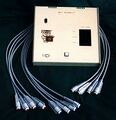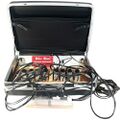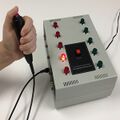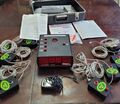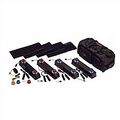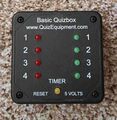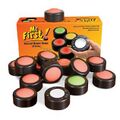Buzzer
Tossup-Bonus Format
(Tossups · Bonuses)
Studying · Writing · Editing
NAQT · ACF · Housewrites
The circuit · Outreach
Resources
hsquizbowl.org
(database · archive · forums)
Discussion forums
College directory
Buzzer system, buzzer, and lockout system are the common names for the device used to indicate which player has signaled their desire to answer a question first. Such systems are necessary for all standard quizbowl games because they make it clear which player was the first to attempt to answer a question.
While using a buzzer system, players buzz to answer a question. Other players are prevented from buzzing ("locked out") after one player has buzzed until the system is reset.
A buzzer system consists of a control unit that sits near the moderator, which connects to individual buttons or paddles held by each player. When a player buzzes in, the system produces a sound and activates a light indicating which player buzzed. Many more expensive systems have individual lights next to each player, while most lower-priced systems have smaller lights or light only on the control unit.
Almost all tournaments require some number of teams to bring buzzers in order to have enough to run the tournament properly; for this reason, Tournament directors usually offer a discount to teams that bring a buzzer. When too few buzzers are present, teams must play slapbowl, where buzzing is indicated by slapping the desk or saying something like "buzz." This is no longer common in the vast majority of modern quizbowl tournaments.
Online tournaments typically use an online buzzer system like Buzzin.live, which functions for players in much the same way as an in-person buzzer. It is possible to use USB buzzers attached to players' computers as the activator for online buzzers, though this is not necessary and generally either a mouse or a phone touchscreen is used. While physical buzzers may use pure electronic hardware logic to determine who has buzzed first, online systems used in serious tournament play must account for varying Internet speed/lag through various approaches, in order to actually determine who has buzzed first in real time rather than who has the best connection to the server.
History of Quizbowl Buzzers
The earliest quizbowl-style competitions appeared to use either a system of hand-raising (sometimes with other officials activating a buzzer after seeing a hand raised) or shouting the answer before the other team. The College Bowl TV show implemented a buzzer system as part of its studio set, but portable buzzers took longer to emerge. The Berry College team in 1971 created a home-made portable buzzer system while a patent for a portable buzzer system was filed in 1972. Previous "lockout" buzzer systems had been used by Bible Bowl as early as the 1950s, but they were apparently not very portable. John P. Reynolds of Dayton, OH, who was likely affiliated with Bible Bowl, is the inventor of the buzzer system under the most straightforward interpretation of the concepts of "inventor" and "buzzer system."
To be usable in quizbowl, buzzer systems now have some kind of light that indicates who buzzed in first, as well as a sound that alerts the reader to stop reading the question and look for the light. Some older buzzer systems used a mechanical bell or other physical device instead of making a "buzz" sound. All currently manufactured systems play an electronically synthesized tone of some kind, with the QuikPro being closest to an onomatopoeiac "buzz" sound. Most current systems use two or more tones of different pitches and/or lengths, so that which of the teams has buzzed can be determined by sound alone before searching for the individual player using the lights.
Choosing a buzzer system (2019 Em Gunter post)
There are many things to take into consideration when deciding which buzzer system to purchase including price, durability, portability, and other factors. Below is a brief overview of Em Gunter's guide to choosing a buzzer system on the hsquizbowl.org forums. This covers 4 of the most commonly seen systems that can still be purchased as of March 2020 (thus leaving out The Judge, which appears to be unavailable for purchase anymore, but which due to its near-indestructibility remains present on many circuits).
Anderson Buzzers: [$265-$290]
Anderson buzzers come in two versions: daisy-chained boxes and individual hand-held indicators. purchasing the daisy-chained version is suggested due to their ease of use and high durability. When disassembled these buzzers only have 4 parts making it nearly impossible to accidentally leave part of the system lying around. The control unit is a simple box and each strip of buzzers connects on either side of the unit. These buzzers are extremely durable and are only known to fail in cases of extreme negligence. Andersons are the cheapest and most reliable buzzers that can be purchased and are often recommended over any other system. In general, it is a much better idea to purchase two sets of Andersons rather than a single set of QuikPros or Zeecrafts due to the far superior build of the Andersons. The one downside, however, to Andersons is that the AC adapter for the system is extremely short so purchasing an extension cord is highly suggested.
BuzzerSystems.com Buzzers: [~$299]
The buzzers from BuzzerSystems.com feature a control unit with individual activators contained within boxes that connect to the control unit by audio cables. The control unit features a reset button and 16 ports to allow the support of up to 16 players which is higher than any other commonly found system. Set up of this system is slightly more complicated than the Andersons because you have to plug a cable into each individual activator and a port on the control unit. Players who enjoy holding their activator but are seeking a higher quality or cheaper set will most likely prefer this set over Andersons. The main downside to this system is the quality of the cables that come with the set when you purchase it. When purchasing this system it is recommended that you additionally invest in a set of replacement cables that can be found at Amazon or a local electronics retailer.
QuikPro Buzzers: [$289-$489]
QuikPro buzzers come in two general types. You either have hand-held activators directly connected to the control unit from a single connection or individual lights with hand-held activators attached. The version with hand-held activators but not lights are generally far more reliable than the version with individual lights. QuikPro buzzers use cables similar to those used for home telephones and the connectors are often prone to snapping. The reset button on QuikPro buzzers can often fail due to poor wiring and may require the splicing of new wire in for continued functionality. The set up of this system is fairly simple but there are many cords that can easily get tangled or damaged which can increase set up and tear down time significantly compared to other systems.
Zeecraft Buzzers: [$465-$730]
These are by far the most expensive buzzers you can buy and while they look extremely nice they don't hold up very well. Many people have experience with these sets as they commonly show up at various national championship tournaments. Zeecraft systems have 8 individual lights with individual hand-held activators. The individual lights themselves are extremely fragile and will crack or pop off if they fall on the ground or jostle inside the case. The buzzers connect to the control unit using telephone cables and the clips on these tend to snap off quite easily. The craftmanship of Zeecraft buzzers is inferior to that of other systems. The soldering is often messy and these systems fail significantly sooner than other systems available for purchase. Additionally, Zeecrafts are incredibly time-consuming to set up and take even longer to put away due to the barely-big-enough case designed for the system. Taking into account the very high cost and lack of durability it is suggested that you stay away from Zeecraft buzzers for individual team use.
Model-specific information
This table is intended to aggregate information about all models of buzzer that are usable for ordinary NAQT/ACF-style quizbowl, including those that are no longer manufactured. Systems that may be suitable only for Knowledge Bowl or other peripheral formats will be added in the future.
| Manufacturer | Model | Still being made as of 2022? | Lowest cost for usable system[1] | Advantages | Disadvantages |
|---|---|---|---|---|---|
| 4 D Designs | Combo Quik Pro | Yes | $395 | This newer system is a good balance of the Quik Pro's benefits with innovations to make it more compact and less fragile. The individual activators have a button set in the middle of a light and are permanently hardwired together; the only thing to plug in is one connector per team. The whole system fits in a shoebox and is only a few inches larger than the miniaturized Anderson system so it's one of the most portable. All Quik Pro models except the Basic have a small timer mounted to the system - this can be used for various game timing functions though it is not visible to the players like the Zeecraft timers are. | Because each team side is permanently hardwired, the individual activators are not modular; if you have an 8-player system and one activator fails then there is no way to "switch it out" and the whole thing has to be sent in for repair. However, the system seems to be fairly durable and may not have this issue often. The only connector in the system is the unusual Quik Pro data port, so there's no off-the-shelf extension available like there is for phone/Ethernet/RCA style cords; conversely, when the connectors are long enough to accommodate a medium-sized classroom, it's recommended to tape them down to the floor to avoid tripping hazards. Repairs for Quik Pro systems tend to be expensive in comparison to other manufacturers. |
| 4 D Designs | Quik Pro Basic | Yes | $289 | Good loud buzzing sound, affordable cost, extremely compact and easy to set up (just plug it into the wall and you're done). | Lights on control unit only (no light physically in front of each player). |
| 4 D Designs | Quik Pro Deluxe | Yes | $489 | "Siren" style lights are the most visible available and are good for larger rooms or for formats that require recognizing by buzzer color. They are easily recognized as a "buzzer system" even when not plugged in and are a good eye-catching aid in recruitment environments such as activities fairs. Timer included. | Plastic on sirens cracks fairly easily, especially if you're trying to balance the whole system on a classroom desk where it will inevitably fall off. Recommend using some velcro/tape to secure the components to the desk surface to try to avoid this happening too often. RJ11 connectors have the usual issues (perhaps even more so since unlike the Zeecraft the connector end goes into the individual buzzer rather than the control unit and will be moving around constantly) so be prepared to perform maintenance. |
| 4 D Designs | Quik Pro Deluxe Strobe | Yes | $518 | Strobe may be a good solution for improving visibility in very large rooms. Timer included. | Same as the Deluxe. |
| Anderson Enterprises | Officiator Elite | Yes | $448 | By far the simplest and most compact system for accommodating more than 10 players, e.g. at large practices or in certain "Bee" formats. Variable volume control. | Lights on control unit only (no light physically in front of each player). |
| Anderson Enterprises | Officiator Handheld/Handpad | Yes | $320 | Probably the best connector style for detachable handheld activators - they don't tend to fall out like the NEDs or break like the Zeecraft/QuikPros. Available in cylinder button or "slap-pad" styles. Variable volume control. | Lights on control unit only (no light physically in front of each player). |
| Anderson Enterprises | Officiator Tabletop | Yes | $290 | Generally considered one of the best values for a new buzzer - despite the issues mentioned here you can usually get a few years out of it before sending it in for a cheap repair. Very appealing when looking at long-term cost of ownership. Variable volume control. Since 2020 or so this system has been offered in a miniaturized version that's easier to transport and so far seems to have fewer of the maintenance issues. Anderson has a good reputation for effective customer service & affordable repairs when needed. The cords from the first buzzer in each team chain to the control unit are fairly long and work for almost any room setup without worrying about purchasing extensions. | Hard-wired connections on both sides of 8 out of 10 activators mean there is no way to pack the system without stressing and, sooner or later, breaking the wires. Reset button can stick. LEDs on activators will often sink into the unit, though this is fairly easy to repair. Power pack is fragile and is subject to the wire breaking/fraying or the pack simply ceasing to work after a period of time. A lot of players have an annoying habit of covering the light on these systems when they buzz, so you will need to remind people not to do that. |
| Boling[2] | Funbuzzer | Yes | $445 | ||
| Edapi | Genius Game | Yes | ~$365[3] | ||
| Novel Electronic Designs/BuzzerSystems.com | 10-Player Quiz System | Yes | $360 | Of the major manufacturers, NED systems are probably the most historically reliable in terms of need for repair per hour of use, and they tend to accumulate less visible wear and tear over time than similarly priced systems. | The RCA-style connectors used in these systems are imperfect and are too easily yanked out by normal movement or loosened over time. Securing the connections with additional tape etc. is recommended if feasible for your use conditions. This model doesn't have lights in front of the players. |
| Novel Electronic Designs/BuzzerSystems.com | High-Visibility Buzzer System | Yes | $559 | Same as other NED systems plus larger individual desktop lights. | Same as other NED systems. |
| Novel Electronic Designs/BuzzerSystems.com | Line-Up Chain-Link Quiz System | Yes | $645 | Same as other NED systems. | The handheld activators that go to the desktop units have the same issue as other NED systems with RCA connectors. The other connectors in this system are eight-pin style similar to Anderson connectors. |
| Novel Electronic Designs/BuzzerSystems.com | Team-Box Quiz System | Yes | $475 | Same as other NED systems. | Lights on control unit only (no light physically in front of each player). Same issue with RCA connectors. |
| Novel Electronic Designs/BuzzerSystems.com | Traditional Buzzer System – BASIC | Yes | $339 | Same as other NED systems. | Same as other NED systems. |
| Novel Electronic Designs/BuzzerSystems.com | Who's Next? Buzzer System | Yes | $399 | Offers a functionality for determining who buzzed second, third, etc that can be switched on or off as desired. | Same as other NED systems. |
| Quiz Equipment | A/G Quizbox | Yes | $465 | Quiz Equipment activators are all modular and are available in various form factors including slap-pads and handheld cylinders. | |
| Quiz Equipment | Basic Quizbox | Yes | $305 | ||
| Quiz Equipment | Quizbowl Quizbox | Yes | $436 | ||
| Quiz Equipment | World Bible Quiz system | Yes | $535 | ||
| QuizSystems | QS2000A | Yes | $260 | ||
| Rolls | GS76RL Game Show Controller | Yes | Lists for $189 new though currently sold out, not sure if more are being manufactured | Compact but still has individual lights | |
| Trebisky | Game Show Buzzer | Yes | $90 | The lowest-priced new system, and is sold through Amazon so has lots of payment options. | Extremely fragile system using very cheap components that is likely to arrive with at least one activator already broken. There is no way that this system will stand up to the ordinary wear and tear of travel or game use. The system as designed theoretically meets tournament usability requirements, but in reality is probably not suited for actual quizbowl team needs and is better used for non-quizbowl classroom or entertainment applications. |
| Triple-Q/Sho-Me | Smart Light | Yes | $450 | The images of this system look identical to the JBQ bar system - possibly the original manufacturer was acquired by Triple Q? | |
| UniAsia[4] | QZ-825 | Yes | $115 | At this price, if you can get 2 years out of them, it's probably worth it even if they don't last longer than that. | From pictures, this seems to be basically the same design as the no-longer-made SVBZ buzzers, which proved somewhat fragile and difficult to set up. |
| Zeecraft | Challenger I | Yes | $495 | All Challenger models accommodate either the "regular buzzer" (unit with button and small light for each player), the "Showtime handgrip" ("trigger" style buzzer with separate large rectangular light unit for each player), or the "Showtime tabletop" (the smaller square light unit). Loud buzzing tone that's less harsh than the QuikPro. | RJ11 connectors break easily, though these are fairly simple to repair. The Showtime handgrips have large plastic covers that will probably crack if dropped repeatedly; as with the Quik Pro Deluxe, you should try to secure them to the table when using to avoid this. Properly setting up and repacking the system, including using velcro or tape to avoid damage to the Showtime units, takes longer than any other currently manufactured buzzer (though not as long as the SVBZ). |
| Zeecraft | Challenger II | Yes | $610 | Various built-in timing functions; can show a visible countdown for an NAQT-style game clock or rules such as 5 seconds per bonus part, etc. | RJ11 connectors break easily, though these are fairly simple to repair. |
| Zeecraft | Challenger III | Yes | $720 | Adds lights on the control unit to the Challenger II features. | RJ11 connectors break easily, though these are fairly simple to repair. |
| Zeecraft | Discover | Yes | $365 | Lights on control unit only (no light physically in front of each player). | |
| Anderson Enterprises | Officiator Deluxe | No | Model discontinued. The similar Officiator Elite is now offered instead. | Has an LED screen on the control unit to display certain information about buzzing order. | |
| Creative Electronic Designs | Quiz Wizard II | No | Company is no longer in business. | Can accommodate 16 players in large practice environments etc. Generally fairly durable; one or two buzzers may go dead but these systems are well over 20 years old and are still seen from time to time. Long cords. | Everything is hardwired together, which combined with the cord length means it can become tangled, hence "The Knot." No way to do individual activator repairs. This system has no lights at all; when a player buzzes, the moderator must read their buzzer number from an LCD screen. Annoyingly, the buzzers are numbered A1 through A4, B1 through B4, C1 through C4, and D1 through D4, which means you shouldn't use both D and B in a game since those are hard to distinguish. The buzzer numbers inscribed on the activators wear off over time so the only way to determine the numbers is for everyone to remember what comes up at the buzzer check. The additional step of calling out the buzzer number means that these systems should probably not be used in timed games (e.g. official NAQT national events). For a "barebones" system with no special features, the unit is surprisingly large; it takes up about as much space as a Quik Pro Deluxe or other system that uses that space to provide individual light units to each player. |
| Educational Technologies | Inquisitor | No | Company is no longer in business. | ||
| Electramatic | The Judge | ??? | Electramatic has always had a very basic and uninformative web presence. It may still be possible to order this system by phone, or not. | Simple setup (basically just take the single hard-wired mass of equipment out of the case). | Breaks easily, especially the covers on the lights which protrude from the case and are not protected in any way. Everything being hardwired together with relatively short cords means that there's little flexibility in adapting to room setups and it's extremely easy for one errant move to drag the whole system to the floor. No lights in front of individual players. Confusing "timer" function on the reset switch often causes problems with uncleared buzzers in games. |
| JEM | Buzz Box | Maybe | |||
| Logitek | Quiztron | No | Company is no longer in business. | Buzzer lights are encased in the most enormous pieces of translucent plastic known in any buzzer system, with twelve panes over a foot long used in each system. This means they are very easily cracked and the remaining examples of these buzzers all look very beat-up. | |
| Novel Electronic Designs/BuzzerSystems.com | Deluxe System | No | Model discontinued. The similar Line-Up Chain-Link Quiz System is now offered instead. | ||
| Paléogénies | Génies-Box | Maybe | |||
| Pitsco | Quiz Wizard I | No | Pitsco Education is still in business and will likely be able to repair old systems, but they no longer manufacture new buzzers. | Very durable, compact, easy-to-set-up system. | Lights on console only, no individual player lights. The system does a 3-second "self-test" routine every time it is reset rather than just when initially powered up, which is annoying and in timed formats possibly makes it unusable. |
| QuizCo | The Quiz Machine | No | Company is no longer in business. | Can extend lengths with off-the-shelf RCA cords. | Electronic design of this system is completely dependent on "daisy chain" signal pass-through; one dead activator or cord will make every subsequent unit in the string unusable, so testing and avoiding disturbing the cords throughout the game becomes even more important than usual. System exhibits other weird behavior at times (e.g., touching anything conductive to the cord ports will cause the buzzer to go off). |
| SVBZ | SVBZ System | No | Company is no longer in business. | Both an AC adapter and a battery powered mode (9-volt) are available by default. | This system uses a huge tree of wires to connect the activators to the control unit and must be totally pulled apart and separated (preferably in individual plastic bags or similar) before being repacked. If you try to pack it up without undoing all the connections even once it will become a hopeless tangle and require 15+ minutes of work to get back to a usable state. Components are cheap and fail often. With SVBZ out of business and the system out of warranty, you should only use this system if you can acquire 2 of them, as that is the only way to have a reasonable shot at pulling enough working parts to make one fully usable system. All connections need to be pushed together as tightly as possible or buzzers will stop working and you will have to hunt through the spiderweb of wires to find the problem. Many people find the buzzing noise on this system to be harsh/unpleasant. |
| University Research Company | Quiz-a-Matic Professional | No | Company is no longer in business. | Adds individual colored lights and a detachable handheld cylinder-button activator to the original Q-a-M design. Branded with College Bowl logo. | |
| University Research Company | Quiz-a-Matic | No | Company is no longer in business. | Very reliable system with many units from 30+ years ago still functioning in quizbowl. Extremely good ergonomics on the button design, and a quaint "bell" sound is used for the buzzing noise. | Each team side is hardwired together, so there is a possibility of wire stress when packing and it's not possible to replace just one buzzer. With the company defunct, unless you can figure out how to fix the electronics on your own, once the unit goes below 8 working activators it's done for. |
Notes on buying used buzzers
Buzzer systems fairly often appear on resale websites, primarily eBay but also sometimes Etsy, Goodwill, and government auction aggregators. Often these were buzzers owned by secondary schools which closed and whose movable property was sold as a lot to a dealer, or systems formerly owned by non-quizbowl campus groups such as college activities offices affiliated with now-defunct programs (e.g. ACUI College Bowl).
- Don't buy a buzzer that won't be usable - the most common system seen here is the Trebisky Game Show Buzzer, which is marketed to a more general audience than quizbowl and primarily uses eBay and Amazon to reach buyers. As mentioned above, while information on this system is included because its technical layout meets the criteria for quizbowl buzzers, it is not a good choice for a quizbowl team and will basically be a waste of money (or time as you return it). The UniAsia QZ-825 also appears on eBay very often; it's possible that this is a more reliable system, but it has not been seen in mainstream quizbowl yet and nothing can be said for sure.
- Extend your search terms- Most people making these sales are not "quizbowl people" and are guessing at what the item is called. Search for "quiz buzzer," "lockout system," "trivia," brand names such as Quik Pro, Zeecraft, etc., and be prepared to scroll past a lot of false positives.
- Read terms- A lot of bulk sellers will, as a policy, not test or guarantee any electronics. Buying an "as-is" buzzer system is a needless risk and should generally be treated as code for "buying a non-working system." Sometimes, smaller sellers will be willing to plug in and test a system if you tell them how to do it - remember, they are not quizbowl people, they will need a little nudge as to what you are looking for.
- The value proposition of a used buzzer is totally different than a new one because you are getting a discount. The reasons that it might not make sense to pay $700 for a Zeecraft become almost irrelevant if someone is selling the same unit for $100. The least expensive new buzzers that are generally expected to be usable over the long term include the $289 QuikPro Basic, the $290 Anderson Officiator Tabletop, and the $360 NED 10-Player. If your budget is lower and you can at least be assured that what you are buying is returnable if it doesn't work, then almost any model of buzzer at substantially less than $289 becomes a good deal.
- Don't be afraid to negotiate, including using eBay's offer system. Most sellers have no idea what prices "should" be and are open to considering lowering prices, especially if the item has been on sale for a while. The inverse of the above point is - if I can get a brand new buzzer for $290 then why would I pay $500 for one that's used, banged up, covered in pieces of tape and writing that says Blahville Middle School, etc? Many sellers will find this persuasive.
- Discuss lowering shipping costs as well. Most systems can be sent through regular USPS for less than $30. If someone insists on charging more and this brings the total cost of the purchase beyond what makes sense, let them know.
- Know what can be repaired on your end - burnt out light bulbs, broken phone jacks, etc. are easy; completely nonfunctional electronic boards aren't. Once you know what you can repair, see what discounted "broken" systems may not be so broken after all. A system that is still supported but is missing one or two working activators might still prove a good deal after calculating the total cost of buying the used system and ordering replacement activators from the manufacturer.
Overall, buying used can be a great option for those on a very limited budget or clubs looking to buy a second or third buzzer in an open-ended timeframe. You will almost always find something usable for under $200 if you know how to search and have a little patience. The more of these units that are brought back into the mainstream quizbowl ecosystem, the better it will be for the issue of supplying buzzers to tournaments.
Purchasing a buzzer system
New quiz bowl programs commonly ask how and where to buy a buzzer system. Overtime all buzzers break down, so it is often better to purchase more durable systems such as Andersons, which are the cheapest and provide good warranties, than to a more expensive system because it looks better or you have heard rumors that it is less likely to fail. Local civic organizations are a good place to reach out to if your school division denies funding for a buzzer system.
There are other concerns about buying a buzzer system for quiz bowl:
- Quiz bowl does not use "self-resetting" systems; you should buy a buzzer with a moderator reset button.
- Wireless buzzer systems are inappropriate for tournament play due to the potential for lag.
- Phone- and tablet-based buzzer systems are inappropriate for tournament play and serious practice due to the potential for distraction or cheating by using such devices' other functions.
- Battery-operated buzzer systems will require you to always keep spare batteries in the case in the event of a mid-tournament battery failure. For tournament use, systems plugging into building power are preferred (it helps to keep an extension cord in the case because some rooms have inconveniently-located power outlets).
- Individual player lights on or next to each player's buzzer make it easier for everyone to recognize who has buzzed in first.
Matt's Buzzers
Matt's Buzzers is a charity set up by Sheryl and Mike Cvijanovich, the parents of Matt Cvijanovich. It awards grants to teams seeking to buy buzzer systems. These grants are given in Matt's honor.
Buzzer exhibit
The Fondren Library at Rice University displays three buzzer systems formerly used by the Rice team as part of an exhibit on the history of Rice's quizbowl program.
Terminology
"Buzzer system" (used in most mainstream quizbowl) and "lockout system" (used in College Bowl) are the most common terms. Game shows such as Jeopardy! that use similar systems refer to them as a "signaling device." The terms "indicator system," "lockout/indicator," and "quiz box" are seen occasionally.
The rules of at least two high school leagues in 2022 (one in Ohio and one in Georgia) still use the trademarked model name "Quiz-a-Matic" to refer to buzzers in general, despite the fact that the Quiz-a-Matic has not been manufactured since 1996, suggesting that this system was once so common that its name began to genericize.
Official systems
While almost all tournaments allow any buzzer that meets their technical requirements and rarely have the luxury of turning away any working buzzers supplied by teams, some models are more common in certain environments:
- NHBB endorses the Anderson Officiator to teams and uses that model for their company-owned reserve of buzzers.
- NAQT owns several dozen NED buzzers and does, or formerly did, have many company-owned Judges as well.
- VHSL Scholastic Bowl uses a stock of Quik Pro Deluxe buzzers at its state tournament and endorses Quik Pro for purchase by participating teams. Scholastic Bowl-only programs almost invariably own a Quik Pro Deluxe with the siren-style buzzers; other models appear at regional-level VHSL tournaments only when more active teams that purchased buzzers outside of VHSL's recommendation supply them.
- Off-TV College Bowl used Zeecraft Challenger I buzzers at its official events after University Research Company stopped making its prior official buzzer, the Quizamatic, in 1996. The purchase of this model by colleges running intramural tournaments and the subsequent end of the College Bowl campus program may explain this buzzer's frequent appearance on secondhand resale websites.
- The Creative Electronic Designs Quiz Wizard II was the official buzzer used by Certamen teams. As of 2023, now that the Quiz Wizard II is no longer being made, the NJCL is making and repairing its own systems. As Certamen involves 12 players at a time, not all quizbowl systems are usable for this format.
- Televised high school quizbowl shows that don't build their own custom buzzers through the TV station's engineers often use Zeecrafts with the Showtime activators, which are fairly easily modified to output to a large light in front of a podium.
The Quik Pro Deluxe "siren" style buzzers provide some advantage in games played before large audiences, as they have by far the largest lights, and the only large lights that are omnidirectional, of any available system. In extreme cases (e.g. national finals games played on stages in hotel conference rooms in front of hundreds of people) there is no out-of-the-box buzzer that lights up brightly enough to overcome the combined effects of the stage lighting and the size of the room, and the audience has to rely on listening to who is answering the question to determine who buzzed. The only way to overcome this is to re-route the light bulb socket in a buzzer that uses lamps (such as certain Zeecraft or NED models) to a larger, more powerful light on the front of the players' table/podium; outside of televised events, this method was once commonly done at the National Academic Championship and was used for the finals of the 2004 PACE NSC.
Gallery of buzzer systems
Manufacturer:Paléogénies
Model: Génies-Box used for Génies en herbe and related competitions in QuebecManufacturer:
Model: Bible Bowl system that was produced by third-party builders & also made freely available as a schematicManufacturer: Ion Electricals
Model: System used in Indian quizzing
Reference for common buzzer parts & repair tools
- Anderson power pack - available on their website http://www.andersonbuzzersystems.com/replacementparts.html, if using a third-party power supply, set output to 9V and use the 3.5mm connector (off-the-shelf power packs should come with an assortment of connectors)
- Bulbs for Zeecraft "showtime" activators - #47 or #1847 "bayonet" or "pinball" style such as these: https://www.amazon.com/dp/B09LC968GK (LED) or https://www.amazon.com/gp/product/B00455IHYM (traditional incandescent filament) Note - Modern LED bulbs placed in older Zeecraft systems will glow faintly whenever the system is plugged in, but they will still clearly get much brighter when the player buzzes and are entirely usable for the purposes of a buzzer. If you can get old incandescent bulbs, they won't do this, but they are more expensive, you will have to replace them more often and, at some point in the future, such bulbs will no longer be made.
- Bulbs for NED systems - while these look superficially similar to the Zeecraft bulbs they are not interchangeable. NED sells replacement LED bulbs here: https://buzzersystems.com/product/light-bulb-long-life-red/ and the specs per their page are 12-14V, 25mA, T 3-1/4 BA9S size
- Fuses for QuikPro systems - 0.5 amp 1" x 1 1/4" glass tube, e.g. these: https://www.amazon.com/dp/B000BXHWAM
- Soldering iron for wire connections - any kind, available anywhere hardware is sold
- Crimping kit for RJ11 ("phone jack") and RJ45 ("Ethernet") tab connectors used by QuikPro, Zeecraft, and other manufacturers - https://www.amazon.com/gp/product/B0756SN86D or any similar kit plus pack of connectors https://www.amazon.com/gp/product/B008EAK1FM
- Screwdrivers are needed for opening Anderson units to fix sunken bulbs, opening Zeecraft showtime light units to replace the bulbs, and other general repair tasks. These will be included in most crimping kits, otherwise supply your own.
Keeping the above tools and parts with your buzzer can save a tournament from running short.
- Buzzer cases: All extant manufacturers sell bags or cases that are intended to fit their buzzers; check the appropriate websites. Otherwise, nearly every system will fit into one of the following options:
- 16 or 20 inch toolboxes: https://www.amazon.com/gp/product/B000HD60PE or https://www.amazon.com/gp/product/B0032Y8RIS, also available at any store that sells hardware or fishing supplies
- "Catalog cases" - for example https://www.amazon.com/Solo-New-York-Classic-USLB1514/dp/B000IJ9O8W/ - these are what NED sells for their systems. The difference between a small "catalog case" and a large "laptop case" is somewhat blurry, so look into all options for the dimensions you need.
- Nearly any system besides the full-size Zeecrafts and the Quik Pro Deluxe will fit in an ordinary household storage bin like this: https://www.amazon.com/Tribello-Clear-Plastic-Storage-Containers/dp/B08H8X25XZ which are sold everywhere
- The new miniaturized Anderson system, original-style Quizamatics, and QuizPro basic systems will fit in an average cardboard shoebox.
External Links
- So You Want to Buy a Buzzer System
- Matt's Buzzers
- Anderson Buzzer Systems
- BuzzerSystems.com
- Quik Pro
- Zeecraft Tech
- Delcom USB Handheld Buzzer
- A Quiz-a-Matic buzzer system being tested





